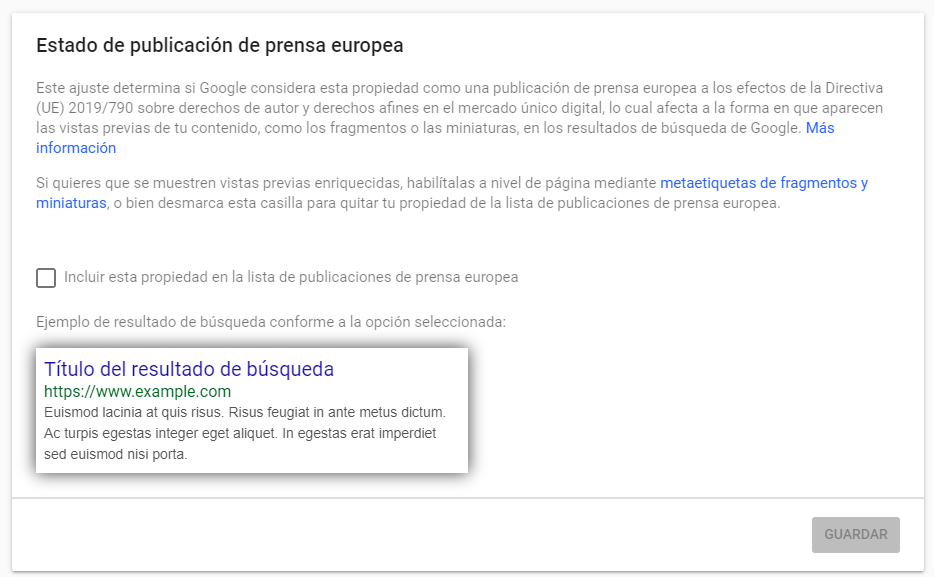Written by Ramón Saquete
The new directives of the meta robots max-snippet, max-image-preview and max-video-preview protect themselves from negative effects, in the format of the media search results due to the possible application of a European copyright directive in Spain and other EU countries (as has already occurred in France). So, as they say, prevention is better than cure and if you see your neighbor’s beard trimmed, soak yours.
In October 2019, a law came into force in France that implements. the european directive on copyright and related rights which prevents the display, without permission or payment, of copyrighted text, images and video data from any page of a medium as Google does in the search results. As a consequence, Google has stopped displaying such information in search results for domains initially classified as belonging to the European press and affected by this law, which, for the time being, should be only French media.
This directive can be implemented by any country in the European Union, so Spain’s media search results could be affected if a law is passed that complies with this directive.
To comply with the requirements of this law, Google has made two changes:
- Add a new configuration option to Google Search Console where we can see if Google has classified the media as belonging to the European press and change this initial classification.
- Add new directives for the robots meta tag, with which we can tell Google that we want to appear in the search results normally, even if we are a European press media.
New configuration screen in Google Search Console
This first change adds to Google Search Console the option to indicate that the property (i.e., the domain or base URL of the media) is or is not a European press publication in a new screen that is currently not yet linked in the Spanish version (it should appear in the configuration section, if implemented).
However, we can enter through the following link if we are logged in:
https://search.google.com/u/2/search-console/settings/eucd

Here we can access the following screen with a check box. If checked, Google visually indicates that it will display the news in the search results without description:

In addition, images and video previews will also not be displayed.
Google tells us that this does not affect positioning. However, since there is no description, no images or video preview, the link will be less attractive to the user and will produce a lower click-through rate. This lower CTR on these results could end up affecting positioning.
According to Google’s indications, if we have this box checked, we should apply the new meta robots guidelines, described in the next point, so that the news will appear in the results normally.
New meta robots directives
The new meta robots directives are max-snippet, max-image-preview and max-video-preview. All of them override the settings set in Google Search Console for the display shown in the previous point.
Let’s look at each of them in detail:
max-snippet: [número]
It is used to indicate the maximum number of characters in the snippet or description of a search result. If we indicate zero, it will be equivalent to the nosnippet directive, which means “do not show the description”. If we indicate a -1, we are indicating that there is no character limit imposed by the medium and this is left to the discretion of the spider.
max-image-preview: [setting]
Sets the maximum image size and supports the following values:
- none: no image.
- standard: you can display the default standard size image.
- large: if the large image exists, you can display the default large image occupying the full width in mobile. If it does not exist, you could display the standard size.
max-video-preview:[number]
Indicates the maximum number of seconds that the video preview can have. If we set a 0 it will use an image instead and with -1 we indicate that there is no limit to the number of seconds it can have.
Therefore, with these directives we can limit how pages appear in search results, whether we are a European press media or not. However, no one who wants to rank will show search results with less information. And whoever does not want to, will directly use the meta robots with noindex value.
Conclusion
In case this European directive is applied to the media in Spain and Google decides to establish that the ownership of the domain is a European press publication, to avoid surprises, it would be advisable to implement the meta robots with the following values in all indexable pages:
<meta name="robots" content="max-snippet:-1, max-image-preview:large, max-video-preview:-1" />
With this we will be indicating that the news should appear in the search results with their images, texts and videos, as they currently do, thus avoiding being harmed by the possible application of this law.



